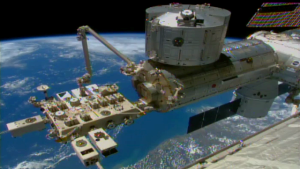Jan 27 2015
On Jan. 22, 2015, robotic flight controllers successfully installed NASA’s Cloud Aerosol Transport System (CATS) aboard the International Space Station through a robotic handoff — the first time one robotic arm on station has worked in concert with a second robotic arm. CATS will collect data about clouds, volcanic ash plumes and tiny airborne particles that can help improve our understanding of aerosol and cloud interactions and improve the accuracy of climate change models.
 This video frame shows a robotic arm on the space station, called the Japanese Experiment Module Remote Manipulator System, successfully installing NASA's Cloud-Aerosol Transport System (CATS) to the Space Station’s Japanese Experiment Module on Jan. 22, 2015. Image Credit: NASA
This video frame shows a robotic arm on the space station, called the Japanese Experiment Module Remote Manipulator System, successfully installing NASA's Cloud-Aerosol Transport System (CATS) to the Space Station’s Japanese Experiment Module on Jan. 22, 2015. Image Credit: NASA
CATS had been mounted inside the SpaceX Dragon cargo craft’s unpressurized trunk since it docked at the station on Jan. 12. Ground controllers at NASA’s Johnson Space Center in Houston used one of the space station’s robotic arms, called the Special Purpose Dexterous Manipulator, to extract the instrument from the capsule. The NASA-controlled arm passed the instrument to a second robotic arm — like passing a baton in a relay race. This second arm, called the Japanese Experiment Module Remote Manipulator System, is controlled by the Japanese Aerospace Exploration Agency. The Japanese-controlled arm installed the instrument to the Space Station’s Japanese Experiment Module, making CATS the first NASA-developed payload to fly on the Japanese module.
After installation, CATS was powered on and is currently sending health and status data back to NASA’s Goddard Space Flight Center in Greenbelt, Maryland, where the instrument’s data will be analyzed, as the team begins their checkout procedures.
CATS is a lidar remote-sensing instrument designed to last from six months to three years. It is specifically intended to demonstrate a low-cost, streamlined approach to developing science payloads on the space station. CATS launched aboard the SpaceX Dragon spacecraft on Jan. 10 from Cape Canaveral Air Force Station in Florida.